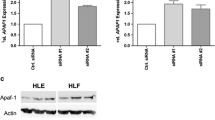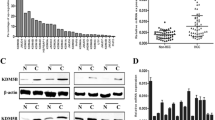Abstract
Background
Histone deacetylase 8 (HDAC8), a member of class I HDACs, has been reported to be involved in transcriptional regulation, cell cycle progression, and developmental events, and several studies have shown that HDAC8 plays a critical role in tumorigenesis. However, the expression level and the potential role of HDAC8 in hepatocellular carcinoma (HCC) remain unclear.
Aim
The purpose of this study was to investigate protein expression of HDAC8 in HCC tissues and the effects of HDAC8 knockdown on the proliferation and apoptosis of liver cancer cells, and to explore the possible mechanisms.
Methods
First, we used quantitative real-time reverse transcription polymerase chain reaction (qRT-PCR), immunohistochemical staining, and western blot to examine the mRNA and protein expression of HDAC8 in HCC cell lines and tissues. Then, we assessed the correlation between clinicopathological parameters and the protein expression of HDAC8. Furthermore, we employed the interfering RNA method to explore the potential role of HDAC8 in HCC progression in vitro.
Results
Our results showed that expression of HDAC8 was significantly up-regulated both in HCC cell lines and tumor tissues compared to human normal liver cell line LO2 and corresponding non-tumor tissues. Moreover, we found that HDAC8 knockdown could dramatically inhibit HCC cell proliferation and enhance the apoptosis rate in vitro. Western blot revealed that intrinsic apoptotic pathway proteins, including BAX, BAD, and BAK, were elevated after HDAC8 knockdown. The cleavage of caspase-3 and PARP, which are downstream of intrinsic apoptotic pathway, were also enhanced. In addition, suppression of HDAC8 also elevated the expression of p53 and acetylation of p53 at Lys382, whereas the acetylation of p53 at Lys373 did not change.
Conclusions
Our study revealed that HDAC8 was overexpressed in HCC. HDAC8 knockdown suppresses tumor growth and enhances apoptosis in HCC via elevating the expression of p53 and acetylation of p53 at Lys382. HDAC8 might serve as a potential therapeutic target in HCC.




Similar content being viewed by others
References
Jemal A, Bray F, Center MM, et al. Global cancer statistics. CA Cancer J Clin. 2011;61:69–90.
Wild CP, Hall AJ. Primary prevention of hepatocellular carcinoma in developing countries. Mutat Res. 2000;462:381–393.
Yoo HY, Patt CH, Geschwind JF, et al. The outcome of liver transplantation in patients with hepatocellular carcinoma in the United States between 1988 and 2001: 5-year survival has improved significantly with time. J Clin Oncol. 2003;21:4329–4335.
Glozak MA, Seto E. Histone deacetylases and cancer. Oncogene. 2007;26:5420–5432.
Marks PA, Xu WS. Histone deacetylase inhibitors: potential in cancer therapy. J Cell Biochem. 2009;107:600–608.
Weichert W, Roske A, Gekeler V, et al. Association of patterns of class I histone deacetylase expression with patient prognosis in gastric cancer: a retrospective analysis. Lancet Oncol. 2008;9:139–148.
Weichert W, Roske A, Niesporek S, et al. Class I histone deacetylase expression has independent prognostic impact in human colorectal cancer: specific role of class I histone deacetylases in vitro and in vivo. Clin Cancer Res. 2008;14:1669–1677.
Weichert W, Roske A, Gekeler V, et al. Histone deacetylases 1, 2 and 3 are highly expressed in prostate cancer and HDAC2 expression is associated with shorter PSA relapse time after radical prostatectomy. Br J Cancer. 2008;98:604–610.
Krusche CA, Wulfing P, Kersting C, et al. Histone deacetylase-1 and -3 protein expression in human breast cancer: a tissue microarray analysis. Breast Cancer Res Treat. 2005;90:15–23.
Fritzsche FR, Weichert W, Roske A, et al. Class I histone deacetylases 1, 2 and 3 are highly expressed in renal cell cancer. BMC Cancer. 2008;8:381.
Weichert W, Denkert C, Noske A, et al. Expression of class I histone deacetylases indicates poor prognosis in endometrioid subtypes of ovarian and endometrial carcinomas. Neoplasia. 2008;10:1021–1027.
Waltregny D, De Leval L, Glenisson W, et al. Expression of histone deacetylase 8, a class I histone deacetylase, is restricted to cells showing smooth muscle differentiation in normal human tissues. Am J Pathol. 2004;165:553–564.
Oehme I, Deubzer HE, Wegener D, et al. Histone deacetylase 8 in neuroblastoma tumorigenesis. Clin Cancer Res. 2009;15:91–99.
Park SY, Jun JA, Jeong KJ, et al. Histone deacetylases 1, 6 and 8 are critical for invasion in breast cancer. Oncol Rep. 2011;25:1677–1681.
Cheng J, Xie HY, Xu X, et al. NDRG1 as a biomarker for metastasis, recurrence and of poor prognosis in hepatocellular carcinoma. Cancer Lett. 2011;310:35–45.
Noske A, Denkert C, Schober H, et al. Loss of Gelsolin expression in human ovarian carcinomas. Eur J Cancer. 2005;41:461–469.
Zhang F, Wu LM, Zhou L, et al. Predictive value of expression and promoter hypermethylation of XAF1 in hepatitis B virus-associated hepatocellular carcinoma treated with transplantation. Ann Surg Oncol. 2008;15:3494–3502.
Martinou JC, Youle RJ. Mitochondria in apoptosis: Bcl-2 family members and mitochondrial dynamics. Dev Cell. 2011;21:92–101.
Spierings D, McStay G, Saleh M, et al. Connected to death: the (unexpurgated) mitochondrial pathway of apoptosis. Science. 2005;310:66–67.
Datta SR, Katsov A, Hu L, et al. 14-3-3 proteins and survival kinases cooperate to inactivate BAD by BH3 domain phosphorylation. Mol Cell. 2000;6:41–51.
Nayak SK, Panesar PS, Kumar H. p53-Induced apoptosis and inhibitors of p53. Curr Med Chem. 2009;16:2627–2640.
Haupt S, Berger M, Goldberg Z, et al. Apoptosis: the p53 network. J Cell Sci. 2003;116:4077–4085.
Roy S, Packman K, Jeffrey R, et al. Histone deacetylase inhibitors differentially stabilize acetylated p53 and induce cell cycle arrest or apoptosis in prostate cancer cells. Cell Death Diff. 2005;12:482–491.
Wu LM, Yang Z, Zhou L, et al. Identification of histone deacetylase 3 as a biomarker for tumor recurrence following liver transplantation in HBV-associated hepatocellular carcinoma. PLoS ONE. 2010;5:e14460.
Yang Z, Zhou L, Wu LM, et al. Combination of polymorphisms within the HDAC1 and HDAC3 gene predict tumor recurrence in hepatocellular carcinoma patients that have undergone transplant therapy. Clin Chem Lab Med. 2010;48:1785–1791.
Debatin KM. Apoptosis pathways in cancer and cancer therapy. Cancer Immunol Immunother. 2004;53:153–159.
Leibowitz B, Yu J. Mitochondrial signaling in cell death via the Bcl-2 family. Cancer Biol Ther. 2010;9:417–422.
Amaral JD, Xavier JM, Steer CJ, et al. Targeting the p53 pathway of apoptosis. Curr Pharm Des. 2010;16:2493–2503.
Amaral JD, Xavier JM, Steer CJ, et al. The role of p53 in apoptosis. Discov Med. 2010;9:145–152.
Fridman JS, Lowe SW. Control of apoptosis by p53. Oncogene. 2003;22:9030–9040.
Yan W, Liu S, Xu E, et al. Histone deacetylase inhibitors suppress mutant p53 transcription via histone deacetylase 8. Oncogene. 2013;32:599–609.
Acknowledgments
This study was sponsored by Grants from the National Natural Science Foundation of China (No. 81272281) and Zhejiang Provincial Natural Science Foundation for Young Distinguished Scholars (No. R2110125).
Conflict of interest
None.
Author information
Authors and Affiliations
Corresponding author
Additional information
Jian Wu and Chengli Du contributed equally to this work.
Rights and permissions
About this article
Cite this article
Wu, J., Du, C., Lv, Z. et al. The Up-Regulation of Histone Deacetylase 8 Promotes Proliferation and Inhibits Apoptosis in Hepatocellular Carcinoma. Dig Dis Sci 58, 3545–3553 (2013). https://doi.org/10.1007/s10620-013-2867-7
Received:
Accepted:
Published:
Issue Date:
DOI: https://doi.org/10.1007/s10620-013-2867-7




